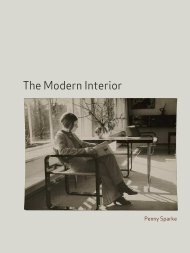Landscape Architecture: Landscape Architecture: - School of ...
Landscape Architecture: Landscape Architecture: - School of ...
Landscape Architecture: Landscape Architecture: - School of ...
- No tags were found...
You also want an ePaper? Increase the reach of your titles
YUMPU automatically turns print PDFs into web optimized ePapers that Google loves.
flourish. This is evident in the design <strong>of</strong> a number <strong>of</strong> new urban<br />
parks, for example, making them characterful yet culturally<br />
porous urban additions rather than merely generic backdrops<br />
to buildings. Gross.Max’s terraced Rottenrow Gardens, for<br />
Glasgow’s Strathclyde University, fulfils this role, functioning as<br />
the outdoor social centre <strong>of</strong> the university for students and<br />
staff, and a hub in a network <strong>of</strong> routes linking the campus.<br />
In France, a radical reinvention <strong>of</strong> the hitherto largely<br />
hermetic archetypical typology <strong>of</strong> the botanic garden was<br />
undertaken in 2002 by Catherine Mosbach, <strong>of</strong> Mosbach<br />
Paysagistes, for the district <strong>of</strong> Bordeaux on the right bank <strong>of</strong><br />
the Garonne River. Instead <strong>of</strong> creating a hermetic garden or a<br />
public park, Mosbach has forged a new hybrid <strong>of</strong> urban<br />
parkland overlaying the historic grid <strong>of</strong> the agricultural land<br />
<strong>of</strong> the La Bastide district here and the old downtown area on<br />
the left bank. Her design includes a water garden, an<br />
environmental ‘gallery’ <strong>of</strong> botanic and agricultural landscapes<br />
laid out in a field <strong>of</strong> wide strips the public is free to wander<br />
through and study – the ecological part <strong>of</strong> the project – and<br />
an ethnobotanic field <strong>of</strong> crops on long irrigated strips <strong>of</strong> land.<br />
A fourth element is a neighbourhood garden for new housing.<br />
The first is a geometric space planted with aquatic species<br />
set above the adjacent road. The gallery is an overly artificial<br />
cross section <strong>of</strong> the Aquitaine Basin region’s natural<br />
classifications – sand dune, water and dry meadows, oak<br />
woodlands, heath and limestone – yet they bring the reality <strong>of</strong><br />
the region to this urban site. Botanic gardens mostly try to<br />
outdo each other with exotic species, but this one plays a<br />
different game, promoting landscape as cultural heritage.<br />
Mosbach describes her vision as a philosophical rather than an<br />
ecological one, using natural flows to draw human movement.<br />
Her largest urban project to date has been a new 7-<br />
kilometre (4 1 / 3 -mile) long walkway along the canal <strong>of</strong> St Denis<br />
from La Villette to the island <strong>of</strong> St Denis in Paris, and she is<br />
currently developing the park for the Louvre’s new regional<br />
museum at Lens in Nord-Pas-de-Calais (a group <strong>of</strong> nine<br />
buildings) on a 20-hectare (40-acre) site, together with<br />
Japanese architects SANAA and New York museum designers<br />
Imrey Culbert. An open relationship between the museum,<br />
nature and the landscape will be achieved through a circuit<br />
taking visitors out <strong>of</strong> the buildings and along glazed paths<br />
winding through a clearing. Jack Lang, the former French<br />
Minister <strong>of</strong> Culture, has described the scheme as ‘a project<br />
that starts from the earth and reaches for the stars’.<br />
Dutch urban designers and landscape architects West 8, led<br />
by founder Adriaan Geuze, established its reputation in the<br />
1990s with projects at home – the Rotterdam<br />
Schouwburgplein and, more recently, the Borneo Sporenburg<br />
docklands development in Amsterdam. The best known <strong>of</strong> the<br />
younger generation <strong>of</strong> landscape architects, the practice, in<br />
stepping aside from the age-old opposition between city and<br />
nature in favour <strong>of</strong> their fusion, has a disciplined, contextbased<br />
methodology. This underlies a frequently surreal,<br />
heterogeneous and <strong>of</strong>ten humorously tongue-in-cheek<br />
The water garden is an irregular grid <strong>of</strong> basins<br />
separated by paved walkways.



